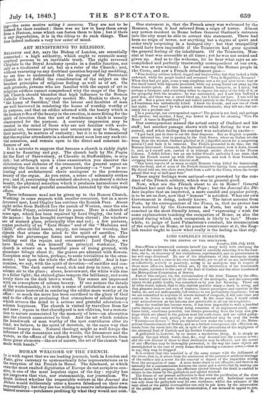ART MINISTERING TO RELIGION.
RELIGION and Art, says the Bishop of London, are essentially connected : a high authority, which ought to reconcile many sceptical persons to an inevitable truth. The right reverend Chaplain to the Royal Academy speaks in a double function, not only as a vindicator of art, but as a ruler of the Church : and, without venturing on any doctrinal question beyond lay meddling, we are free to understand that the dogmas of the Protestant Church do not forbid the consideration of the subject on the broadest principles of religious feeling as well as of art. On such grounds persons who are familiar with the aspect of art in religious edifices cannot comprehend why the usage of the Eng- lish Church should 'abandon that high influence to the Roman Catholic Church. It scarcely needed Mr. Ruskin to show, by "the Lamp of Sacrifice," that the labour and faculties of man are well bestowed in rendering the house of worship worthy of its purpose, and that an edifice adorned with the beauty which is the human reflex of the beauty in the creation, is more fitting for the spirit of devotion than the sort of washhouse which is usually constructed for the purpose. A contrary impression may be created in the mind of those who are not familiar with eccle- siastical art, because pictures and ornaments may to them, by their novelty, be matters of curiosity ; but it is to be remembered that the regular attendants in a church must soon lose any such tri- vial sensation, and remain open to the direct and constant in- fluences of art.
It is a mistake to suppose that because a church is richly dight it must be flaunting and gay. The church built by Mr. Pugin for the Earl of Shrewsbury, at Cheadle in Staffordshire, is very rich ; but although upon a close examination you discover the elaboration and richness of the ornament, the general aspect on entering the fane is one of a grave harmony—a "tone" in co- louring and architectural shade analogous to the ponderous beauty of the organ. As you enter, a sense of solemnity strikes you ; and if, penetrating the subdued shadows, you descry a richer beauty, the physical sensation which it produces harmonizes well with the grave and grateful consolation intended by the religious offices.
These influences need not be given up to the Roman Church. Working in some respects with smaller resources, but in a more favoured spot, Lord Ongley has outdone the Romish Peer. About eight miles from Bedford lies the parish of Warden, once the site of Warden Priory, celebrated for its pears. Here is a church of some age, which has been repaired by Lord Ongley, the lord of the manor : he has brought carvings from abroad ; the windows are of stained glass, principally blue and red ; a few pictures, copies probably of an 'Ecce Homo" and of the "Madonna and Child," after skilful hands, supply, not images for worship, but objects that attune the mind to the spirit of sacrifice. The simple but picturesque forms and arrangement of the older building suit the repairs and ornaments : Lord Ongley, we have been told, was himself the principal workman. The church is situate on a beautiful piece of rising ground, with abundant foliage about it; the graves are adorned with flowers. Exception may be taken, perhaps, to some trivialities in the orna- ments; but upon the whole the effect is beautiful. And it har- monizes, we say, with the spirit of devotion—of sacrifice and con- solation. The dark carved wood, rich and deep in tone, gives a solemn air to the place ; above, heavenward, the white walls rise to a fuller light; the stained glass tempers the brilliancy, and casts lovely tints on the dark brown wood. The senses are impressed with an atmosphere of solemn beauty. If one notices the details of the workmanship, it is with a sense of satisfaction at so much skilful pains bestowed in rendering the edifice more worthy of its office : so much the more has been sacrificed to the glory of God and to the effort at producing that atmosphere of solemn beauty which attunes the mind to a serious and grateful adoration—a solemn happiness. The church is visited by travellers from far and near ; repose in that churchyard is not oblivion, but a restora- tion to nature consecrated by the memory of love—an absorption into the church consecrated to God. And the art which renders the handiwork of man worthy of the spot contributes after its kind, we believe, to the spirit of devotion, in the same way that natural beauty does. Natural theology might as well forego the influence of the mountains and the woods, the firmament and the waters, as the offices of the church forego what art borrows from those great elements—the art of nature the art of the church "not Made with hands."


























 Previous page
Previous page